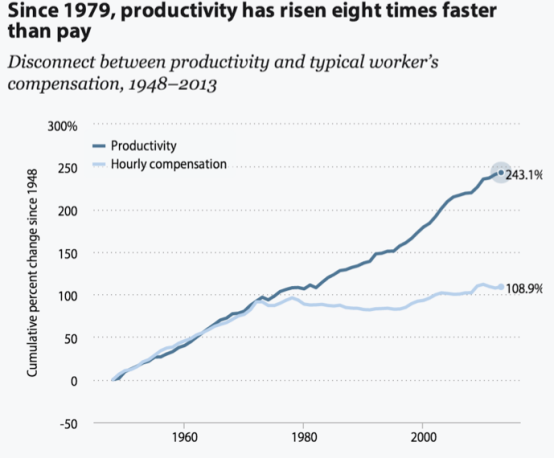Since 1975 workers have received almost none of the gains of increased productivity, which has increased by 143% since around 1975 (figure 14). In other words, productivity has more than doubled, while workers received none of the gains. This can be explained by the deindustrialization of the US economy, as heavy industries followed by manufacturing in general were exported to Asia. Due to this trend there was a huge decrease in unionization which went from 39% in 1940 to around 10% in 2014. During the same period there was a trend toward part-time work and contract labor, mergers and acquisitions, with downsizing and layoffs. The Reagan revolution and Republican “Contract with America” both served to remove power from the working class and transfer it to corporations. One of Reagan’s first acts as President was to break the Pilots and Air Traffic Controllers strike (PATCO), replacing them all with military personnel. That was the final nail in the union coffin. The Democratic Party in 1992 through the Democratic Leadership Conference chose to seek the same corporate and Wall St. money as the Republicans, and from that point on effectively stopped serving the working class. All these factors led to the reduction of bargaining power and political power on the part of labor, and can help explain the stagnating real wages during this period of time.
Topics:
Editor considers the following as important: Uncategorized
This could be interesting, too:
tom writes The Ukraine war and Europe’s deepening march of folly
Stavros Mavroudeas writes CfP of Marxist Macroeconomic Modelling workgroup – 18th WAPE Forum, Istanbul August 6-8, 2025
Lars Pålsson Syll writes The pretence-of-knowledge syndrome
Dean Baker writes Crypto and Donald Trump’s strategic baseball card reserve
Since 1975 workers have received almost none of the gains of increased productivity, which has increased by 143% since around 1975 (figure 14). In other words, productivity has more than doubled, while workers received none of the gains. This can be explained by the deindustrialization of the US economy, as heavy industries followed by manufacturing in general were exported to Asia. Due to this trend there was a huge decrease in unionization which went from 39% in 1940 to around 10% in 2014. During the same period there was a trend toward part-time work and contract labor, mergers and acquisitions, with downsizing and layoffs. The Reagan revolution and Republican “Contract with America” both served to remove power from the working class and transfer it to corporations. One of Reagan’s first acts as President was to break the Pilots and Air Traffic Controllers strike (PATCO), replacing them all with military personnel. That was the final nail in the union coffin. The Democratic Party in 1992 through the Democratic Leadership Conference chose to seek the same corporate and Wall St. money as the Republicans, and from that point on effectively stopped serving the working class. All these factors led to the reduction of bargaining power and political power on the part of labor, and can help explain the stagnating real wages during this period of time.
Gary Flomenhoft
Escaping the Polanyi matrix: the impact of fictitious commodities: money, land, and labor on consumer welfare

